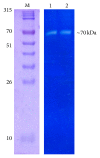Proteomic Characterization of Lytic Bacteriophages of Staphylococcus aureus Isolated from Sewage Affluent of India
- PMID: 27355013
- PMCID: PMC4897502
- DOI: 10.1155/2014/265298
Proteomic Characterization of Lytic Bacteriophages of Staphylococcus aureus Isolated from Sewage Affluent of India
Abstract
Staphylococcus aureus is a Gram-positive bacterium that causes a variety of diseases, including bovine mastitis, which has severe economic consequences. Standard antibiotic treatment results in selection of resistant strains, leading to need for an alternative treatment such as bacteriophage therapy. Present study describes isolation and characterization of a staphylococcal phage from sewage samples. S. aureus isolates obtained from microbial type culture collection (MTCC), Chandigarh, India, were used to screen staphylococcal phages. A phage designated as ΦMSP was isolated from sewage samples by soft agar overlay method. It produced clear plaques on tryptone soya agar overlaid with S. aureus. Transmission electron microscopy revealed that the phage had an icosahedral symmetry. It had 5 major proteins and possessed a peptidoglycan hydrolase corresponding to 70 kDa. ΦMSP infection induced 26 proteins to be uniquely expressed in S. aureus. This phage can be proposed as a candidate phage to treat staphylococcal infections.
Figures





References
-
- Sulakvelidze A., Kutter E. Bacteriophage: Biology and Applications. Boca Raton, Fla, USA: CRC Press; 2005. Bacteriophage therapy in humans; pp. 381–36.
-
- Proskurov V. A. Use of staphylococcal bacteriophage for therapeutic and preventive purposes. Zhurnal Mikrobiologii Epidemiologii i Immunobiologii. 1970;47(2):104–107. - PubMed
-
- Kochetkova V. A., Mamontov A. S., Moskovtseva R. L., et al. Phagotherapy of postoperative suppurative-inflammatory complications in patients with neoplasms. Sovetskaya Meditsina. 1989;(6):23–26. - PubMed
LinkOut - more resources
Full Text Sources
Other Literature Sources

